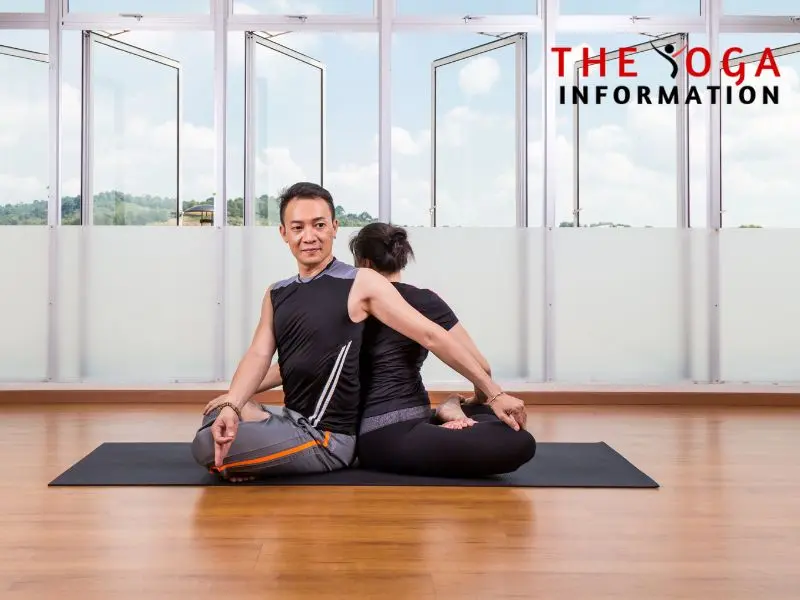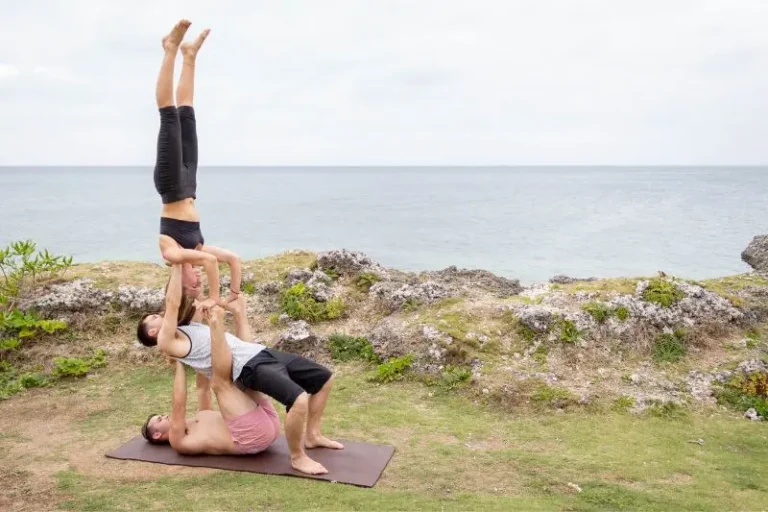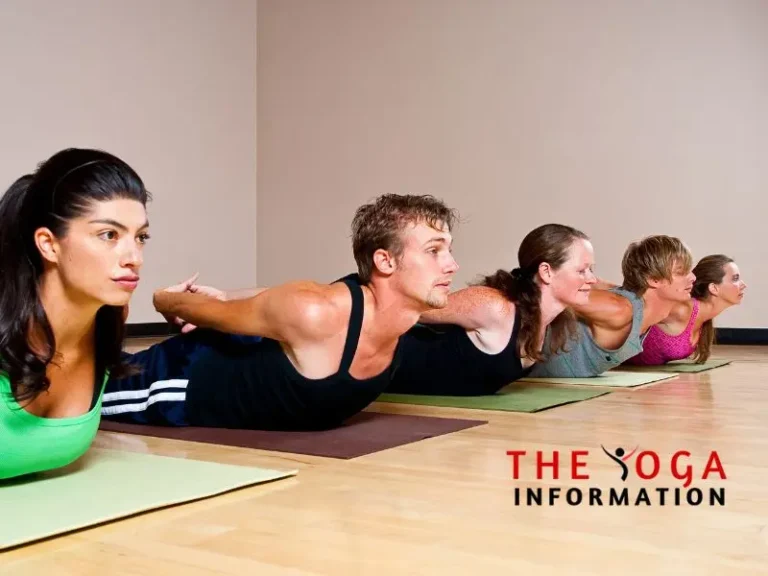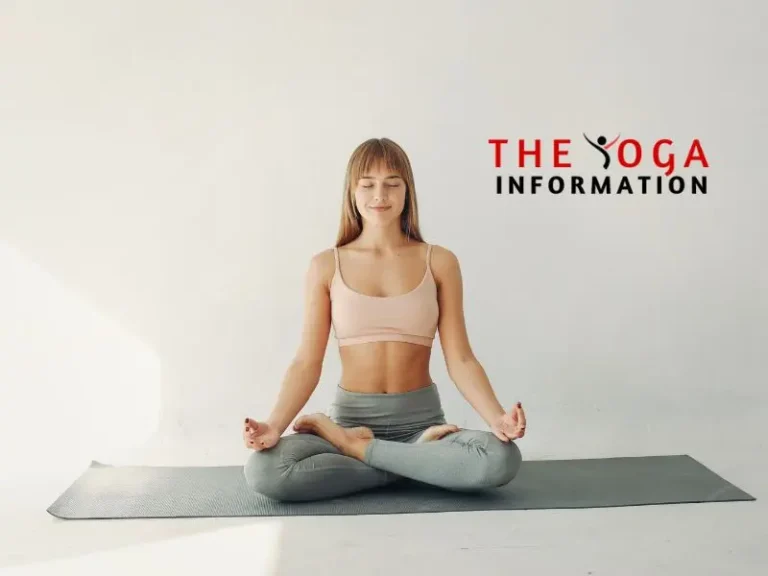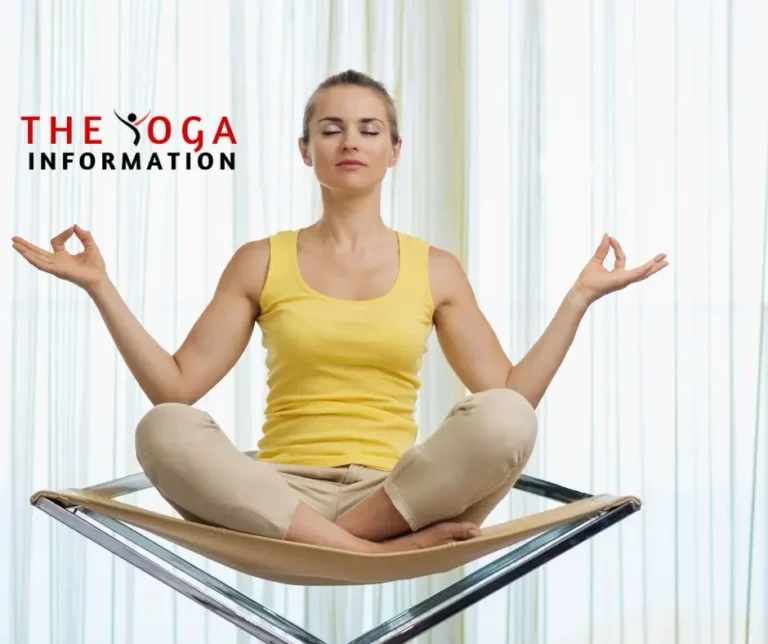Partner Yoga IntroductionAre you looking to deepen your yoga practice while strengthening your bond with a friend, partner, or family member? Partner yoga, also known as acro-yoga or duo yoga, offers a unique and rewarding way to connect with others while experiencing the benefits of yoga together. In this article, we’ll explore 10 dynamic yoga poses for two that will enhance your practice and foster a sense of trust, communication, and teamwork.
10 Dynamic Yoga Poses for Two
Here are 10 dynamic yoga poses for two that you can try together. From the playful “Double Downward Dog” to the challenging “Partner Boat Pose,” these poses encourage communication, trust, and teamwork while providing a unique and enjoyable yoga experience.
1: Double Downward Dog
Double Downward Dog is a variation of the traditional Downward Dog pose, where two individuals come together to perform the pose in a synchronized manner. In this partner yoga pose, both partners assume the traditional Downward Dog position facing each other, with a comfortable distance between them. The pose requires a harmonious balance, as both partners align their bodies to create a stable and symmetrical posture.
Practicing Double Downward Dog
To practice Double Downward Dog, find a partner who is willing to explore this collaborative yoga pose with you. Begin by standing facing each other on your yoga mats, then transition into the traditional Downward Dog pose. Once in position, gently walk your feet closer to your partner’s hands, finding a distance that allows both of you to maintain a stable and comfortable pose. Communicate with your partner to ensure that you both feel secure and balanced in the pose. Hold the pose for several breaths, focusing on synchronizing your movements and breathing with your partner.
Benefits of the Pose
Double Downward Dog offers a multitude of benefits for both partners. This pose promotes deeper stretching and opening of the shoulders, spine, and hamstrings. Additionally, it enhances the sense of connection and trust between partners, fostering a supportive and communicative environment. From a physical standpoint, practicing Double Downward Dog can improve posture, strengthen the upper body, and enhance overall flexibility. Moreover, the collaborative nature of this pose encourages mindfulness and concentration, creating a shared meditative experience.
Tips for Exercising Safely
While practicing Double Downward Dog, it’s essential to prioritize safety and communication with your partner. Follow these tips to ensure a safe and enjoyable experience
- Communicate openly with your partner about any physical limitations or concerns before attempting the pose.
- Start with a brief warm-up to prepare your bodies for the pose, focusing on gentle stretches and joint mobility exercises.
- Maintain a steady and even breath throughout the pose, and avoid pushing yourself or your partner beyond your comfort level.
- Use verbal cues and non-verbal communication to adjust the pose and provide support to each other as needed.
- Respect each other’s boundaries and be mindful of any discomfort or strain that may arise during the pose.
2.Partner Boat Pose
Partner Boat Pose is a variation of the traditional Boat Pose, where two individuals sit facing each other with their knees bent and feet touching. As partners, you will hold each other’s hands and lean back, finding balance on your sitting bones while lifting your feet off the ground. The pose requires synchronization, communication, and mutual support to maintain stability and alignment. It encourages both partners to engage their core muscles, focus on breathing, and establish a sense of togetherness through physical connection
Practicing Partner Boat Pose
To practice Partner Boat Pose, start by sitting facing your partner, with your knees bent and your feet touching. Hold hands and gently lean back, finding a comfortable distance to maintain balance. Once you feel stable, slowly lift your feet off the ground and extend your legs, creating a V shape with your body. Keep your spine long, chest open, and shoulders relaxed. Engage your core muscles to support your lower back and find a steady breath rhythm. Stay in the pose for a few breaths, communicating with your partner to adjust and find optimal alignment.
Benefits of the Pose
Partner Boat Pose offers a wide range of benefits for both physical and emotional well-being. From a physical perspective, it strengthens the core muscles, improves balance, and enhances coordination. It also stretches the hamstrings, stimulates the abdominal organs, and promotes better posture. On an emotional level, practicing this pose with a partner fosters trust, communication, and a sense of unity. It encourages mutual support, patience, and the joy of shared accomplishment. Partner Boat Pose can also help individuals develop a deeper understanding of their own and their partner’s strengths and limitations.
Tips for Exercising Safely
When practicing Partner Boat Pose, safety and communication are paramount. Here are some essential tips to ensure a safe and enjoyable experience
- Communicate openly with your partner throughout the practice. Discuss any concerns or adjustments that may be needed.
- Start with a gentle warm-up to prepare your body for the pose. Focus on stretching the back, hamstrings, and core muscles.
- Avoid forcing the pose or overexerting yourself. Listen to your body and respect your limitations.
- Use the support of each other’s hands to maintain balance and stability. Adjust the distance between you as needed for comfort and alignment.
- Remember to breathe deeply and stay present in the moment. Encourage each other and enjoy the journey of practicing together.
3.Seated Spinal Twist
The Seated Spinal Twist, also known as Ardha Matsyendrasana in Sanskrit, is a seated yoga pose that involves twisting the spine. To perform this pose, partners sit back-to-back with their legs crossed. They then reach for each other’s opposite knee or thigh and gently twist in the opposite direction. This pose promotes flexibility in the spine, shoulders, and hips while also engaging the core muscles.
Practicing the Seated Spinal Twist with a Partner
To practice the Seated Spinal Twist with a partner, sit on the floor with your partner, back-to-back. Ensure that your spines are aligned. As you inhale, lengthen your spine, and as you exhale, gently twist towards the opposite side, using your partner’s support to deepen the stretch. Hold the pose for several breaths before switching to the other side. Communication and synchronization with your partner are key to experiencing the full benefits of this pose.
Benefits of the Seated Spinal Twist
The Seated Spinal Twist offers a range of benefits, both physical and mental. It helps in improving spinal mobility, alleviating back pain, and stretching the shoulders and hips. Additionally, the pose stimulates the digestive system and can help in detoxifying the body. From a mental perspective, the Seated Spinal Twist can promote a sense of relaxation and release tension in the spine and back muscles.
Tips for Exercising Safely
When practicing the Seated Spinal Twist or any other partner yoga poses, safety should always be a top priority. Here are some essential tips for exercising safely
- Communicate openly with your partner about any discomfort or pain during the practice.
- Warm up with some gentle stretches before attempting deeper partner yoga poses.
- Respect each other’s boundaries and never force a stretch beyond your partner’s comfort level.
- Use props such as yoga blocks or straps to modify the poses and provide additional support if needed.
4. Partner Forward Fold
Partner Forward Fold, also known as Paschimottanasana in Sanskrit, is a seated forward bend pose that involves two individuals facing each other in a seated position with their legs extended. The partners then reach for each other’s hands and gently fold forward, allowing for a deep stretch in the back, hamstrings, and shoulders. This pose symbolizes unity, support, and shared energy between partners, making it a beautiful expression of connection and trust.
Practicing Partner Forward Fold
To practice Partner Forward Fold, find a comfortable and spacious area where you and your partner can sit facing each other with your legs extended. Begin by sitting upright and reaching for each other’s hands. As you exhale, gently fold forward while maintaining a strong connection with your partner. It’s essential to communicate and synchronize your movements to create a harmonious and balanced experience. Hold the pose for several breaths, allowing both partners to experience a deep and relaxing stretch.
Benefits of the Pose
Partner Forward Fold offers a myriad of physical, emotional, and relational benefits. Physically, it helps to stretch the spine, hamstrings, and shoulders, releasing tension and promoting flexibility. The gentle pressure from your partner’s hands can enhance the depth of the stretch, allowing for a more profound release of tightness and stress. Emotionally, practicing this pose fosters a sense of trust, support, and unity, strengthening the bond between partners. From a relational perspective, Partner Forward Fold encourages open communication, empathy, and cooperation, creating a shared experience that can deepen the connection between partners.
Tips for Exercising Safely
- Communicate openly with your partner: Prioritize clear communication to ensure that both partners feel comfortable and supported throughout the pose.
- Respect each other’s boundaries: Be mindful of your partner’s flexibility and limitations, and adjust the pose accordingly to prevent any strain or discomfort.
- Warm-up before practicing: Engage in gentle warm-up stretches to prepare the body for Partner Forward Fold and avoid any potential injuries.
- Use props if needed: Consider using yoga props such as blankets or blocks to support your practice and alleviate any strain on the back or hamstrings.
5. Supported Backbend
Supported backbend is a gentle heart-opening yoga pose that can be practiced with the aid of props such as yoga blocks, bolsters, or a partner. To begin, lie on your back with your knees bent and your feet hip-width apart. Place the prop or have your partner gently lift your hips off the ground, creating a supported arch in the spine. Your arms can rest by your sides or extend overhead, allowing your chest to open and expand. The pose encourages a gentle stretch in the front of the body, including the chest, abdomen, and hip flexors, while promoting relaxation and ease in the back muscles.
Practicing Supported Backbend
When practicing supported backbend, it’s essential to approach the pose with mindfulness and awareness of your body’s limitations. If you’re using props, ensure they are positioned in a way that provides adequate support without causing strain. For those practicing with a partner, communication is key to ensure a safe and enjoyable experience for both individuals. As with any yoga pose, it’s important to listen to your body and make adjustments as needed to maintain comfort and stability throughout the practice.
Benefits of the Pose
Supported backbend offers a myriad of benefits for both the body and mind. Physically, the pose helps to improve posture, open the chest and shoulders, and increase flexibility in the spine. It also stimulates the thyroid and parathyroid glands, which can have a positive impact on metabolism and energy levels. Emotionally, the heart-opening nature of the pose can promote feelings of compassion, love, and vulnerability, making it a valuable addition to any mindfulness practice. Additionally, incorporating supported backbends into your routine can help alleviate stress and anxiety, creating a sense of emotional balance and well-being.
Tips for Exercising Safely
To ensure a safe and effective practice, consider the following tips when incorporating supported backbends into your yoga routine
- Start with gentle variations of the pose and gradually progress to deeper expressions as your body becomes more accustomed to the stretch.
- Use props or a partner to provide support and stability, especially if you’re new to backbending or have any existing back issues.
- Focus on maintaining steady and even breathing throughout the pose to promote relaxation and ease in the body.
- If practicing with a partner, communicate openly and honestly about your comfort level and any adjustments that may be needed to enhance the experience.
6. Double Tree Pose
The Double Tree Pose is a variation of the traditional Tree Pose, where two partners stand side by side and support each other to achieve balance and stability. To begin, both partners stand facing each other with a slight gap between them. Each partner then lifts one foot and places the sole against the inner thigh of the standing leg, finding a gentle press to create stability. With a focus on maintaining a steady gaze and steady breath, the partners can extend their arms and join hands, creating a beautiful and harmonious tree-like formation.
Practicing the Double Tree Pose
Practicing the Double Tree Pose requires synchronization, trust, and communication between partners. It is essential to find a suitable partner with whom you share a level of comfort and trust. Start by standing beside your partner and establishing a strong foundation through your standing leg. Gradually, lift the opposite foot and place it against your inner thigh, ensuring that both partners are supporting each other evenly. As you find balance, extend your arms and connect with your partner to create a sense of unity and stability.
Benefits of the Double Tree Pose
The Double Tree Pose offers a wide array of physical, mental, and emotional benefits for both partners. Physically, it strengthens the legs, core, and ankles while improving overall balance and posture. The pose also encourages a deep stretch in the hips and groin, promoting flexibility and release of tension. Moreover, the act of supporting and being supported by a partner fosters a sense of trust, teamwork, and connection, making it a deeply enriching experience for both individuals.
Tips for Exercising Safely
As with any yoga practice, it is crucial to prioritize safety and mindfulness when attempting the Double Tree Pose. Here are some essential tips to ensure a safe and enjoyable experience
- Communication is Key: Establish clear communication with your partner before and during the pose. Use verbal cues or gentle adjustments to maintain balance and support each other effectively.
- Start with a Stable Foundation: Focus on grounding through your standing leg and finding a steady drishti (gaze) to maintain balance and stability.
- Respect Your Limitations: Listen to your body and honor its limitations. Avoid forcing the pose and make modifications as needed to prevent injury.
- Embrace Playfulness and Patience: Approach the Double Tree Pose with a sense of playfulness and patience. It’s okay to wobble and laugh as you navigate the pose with your partner.
7. Partner Warrio
To practice the Partner Warrior Pose, stand facing your partner, about an arm’s length apart. Begin by stepping your right foot back into a lunge position, while your partner steps their left foot back. As you both ground your feet firmly into the earth, extend your arms parallel to the ground, mirroring each other’s movements. Gaze past your front hand, feeling the strength and stability of the pose. Hold the pose for several breaths before switching sides to maintain balance and harmony.
Practicing the Pose
To practice the Partner Warrior Pose, stand facing your partner, about an arm’s length apart. Begin by stepping your right foot back into a lunge position, while your partner steps their left foot back. As you both ground your feet firmly into the earth, extend your arms parallel to the ground, mirroring each other’s movements. Gaze past your front hand, feeling the strength and stability of the pose. Hold the pose for several breaths before switching sides to maintain balance and harmony.
Benefits of the Pose
The Partner Warrior Pose offers a myriad of physical, mental, and emotional benefits. Physically, it strengthens the legs, opens the hips, and improves overall balance and coordination. Mentally, it encourages focus, concentration, and the ability to synchronize movements with a partner. Emotionally, it fosters trust, communication, and a sense of interconnectedness, creating a profound bonding experience.
Tips for Exercising Safely
While practicing Partner Warrior Pose, it’s essential to prioritize safety and communication with your partner. Here are some tips to ensure a safe and enjoyable experience
- Communicate openly with your partner and establish trust before attempting the pose.
- Start with a gentle warm-up and stretching to prepare your muscles for the pose.
- Focus on maintaining proper alignment and balance, and avoid pushing beyond your limits.
- Respect your body’s boundaries and communicate any discomfort to your partner to make adjustments as needed.
- Have fun and embrace the experience of connection and support with your partner.
8. Double Child’s Pose
The Double Child’s Pose, also known as “Balasana” in Sanskrit, is a variation of the traditional Child’s Pose. In this pose, two partners sit back on their heels, allowing their bodies to gently fold forward, resting their foreheads on the ground and reaching their arms out in front of them. The partners’ backs are pressed against each other, creating a supportive and nurturing connection.
Practicing the Double Child’s Pose
To practice the Double Child’s Pose, find a willing partner who is also comfortable with the pose. Sit back on your heels, with your partner mirroring your position. Gently lean forward and rest your forehead on the ground, allowing your partner to do the same. As you both settle into the pose, focus on synchronizing your breath and creating a sense of shared relaxation and support.
Benefits of the Pose
The Double Child’s Pose offers a myriad of benefits for both partners. It provides a gentle stretch for the back, hips, and thighs, helping to release tension and promote flexibility. The pose also encourages deep breathing, which can calm the mind and reduce stress and anxiety. Additionally, practicing this pose with a partner fosters a sense of trust, communication, and emotional bonding, making it an ideal posture for couples or friends to enhance their connection.
Tips for Exercising Safely
When practicing the Double Child’s Pose, it’s essential to prioritize safety and communication with your partner. Here are some tips to ensure a safe and enjoyable experience
- Communicate openly with your partner about any discomfort or limitations.
- Use props such as blankets or cushions to support your bodies if needed.
- Focus on gentle, conscious movements and avoid forcing the pose beyond your comfort level.
- Always respect your body’s boundaries and remember that yoga is about honoring yourself and your partner.
9. Partner Wheel Pose
The Partner Wheel Pose, also known as Chakrasana in Sanskrit, is a variation of the traditional Wheel Pose (Chakrasana). In this partner variation, two individuals work together to create a supportive and stable structure, allowing each partner to experience an exhilarating backbend. One partner acts as the base, lying on their back with their knees bent and feet planted firmly on the ground, while the other partner carefully aligns their hands and feet to create a bridge-like structure, with their partner’s back resting against the arch created by their body.
Practicing Partner Wheel Pose
Before attempting the Partner Wheel Pose, it’s essential to ensure that both partners are adequately warmed up and have a good understanding of individual Wheel Pose alignment and technique. Partners should communicate clearly and establish trust before attempting this pose. Once both partners are ready, they can begin by carefully aligning themselves to create a stable base and support for the backbending partner. It’s crucial to maintain open communication and make adjustments as needed to ensure the safety and comfort of both partners throughout the pose.
Benefits of the Pose
Partner Wheel Pose offers a wide range of benefits for both partners involved. From a physical standpoint, this pose strengthens the back, shoulders, and arms, while also improving flexibility in the spine and hip flexors. Additionally, the pose provides a deep stretch for the chest and abdomen, promoting improved posture and overall back health. On an emotional and relational level, the Partner Wheel Pose fosters trust, communication, and teamwork between partners, creating a sense of connection and shared accomplishment.
Tips for Exercising Safely
To practice Partner Wheel Pose safely, it’s essential to keep the following tips in mind
- Warm up thoroughly with individual Wheel Pose variations and other backbending stretches.
- Communicate openly with your partner and establish clear signals for comfort and adjustment during the pose.
- Start with a spotter or instructor present to ensure proper alignment and support.
- Avoid forcing the pose and respect your body’s limits and capabilities.
- Take time to debrief with your partner after practicing the pose, discussing what worked well and any areas for improvement.
10. Acro Yoga Flying Whale
The Acro Yoga Flying Whale pose involves one partner (the “base”) lying on their back with their legs raised, while the other partner (the “flyer”) balances on the base’s feet and hands, creating the illusion of a majestic flying whale. The flyer extends their body into a graceful arc, engaging their core and finding balance through focused breath and concentration. The base provides stability and support, creating a harmonious partnership as they work together to achieve the pose.
Practicing the Acro Yoga Flying Whale Pose
Practicing the Acro Yoga Flying Whale pose requires clear communication, trust, and coordination between partners. Both partners should warm up their bodies with gentle stretches and partner exercises to prepare for the pose. It’s essential to establish clear signals and cues to ensure safety and effective communication during the practice. As with any partner yoga pose, it’s important to approach the practice with an open mind, patience, and a willingness to support and trust your partner.
Benefits of the Pose
The Acro Yoga Flying Whale pose offers a multitude of physical, mental, and relational benefits. Physically, this pose strengthens the core, shoulders, and legs while improving balance, flexibility, and body awareness. It also fosters trust, communication, and cooperation between partners, deepening the bond and connection between them. Additionally, practicing partner yoga can bring a sense of joy, playfulness, and shared accomplishment, enhancing the overall experience of yoga practice.
Tips for Exercising Safely
When practicing the Acro Yoga Flying Whale pose, safety should always be a top priority. Here are some essential tips to ensure a safe and enjoyable experience
- Communication is key: Establish clear verbal and non-verbal cues with your partner to indicate comfort, readiness, and any adjustments needed during the pose.
- Start with a spotter: Especially for beginners, having a third person (a spotter) present can provide an added layer of safety and support, offering guidance and assistance if needed.
- Build strength gradually: Both partners should gradually build the strength and flexibility needed to perform the pose safely. Start with foundational partner yoga poses and conditioning exercises to prepare for the Flying Whale pose.
- Respect your limits: Listen to your body and know when to take breaks or modify the pose. Never push yourself or your partner beyond your comfort levels or physical capabilities.
Conclusion
Practicing partner yoga offers a myriad of benefits, including improved communication, deeper stretches, enhanced trust, and strengthened relationships. By engaging in dynamic yoga poses with a partner, individuals can experience a fun and rewarding journey towards physical and mental well-being. I encourage readers to explore the world of partner yoga, embrace the unique connection it fosters, and embark on this fulfilling and enriching practice with a friend or loved one. The shared experience of partner yoga has the potential to enrich both your yoga practice and your relationships, making it a truly worthwhile endeavor.
